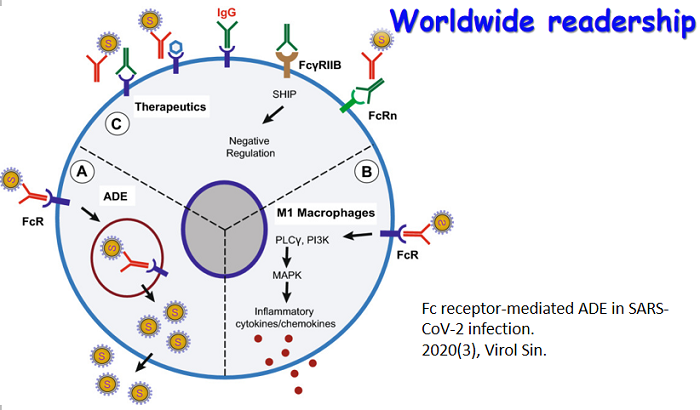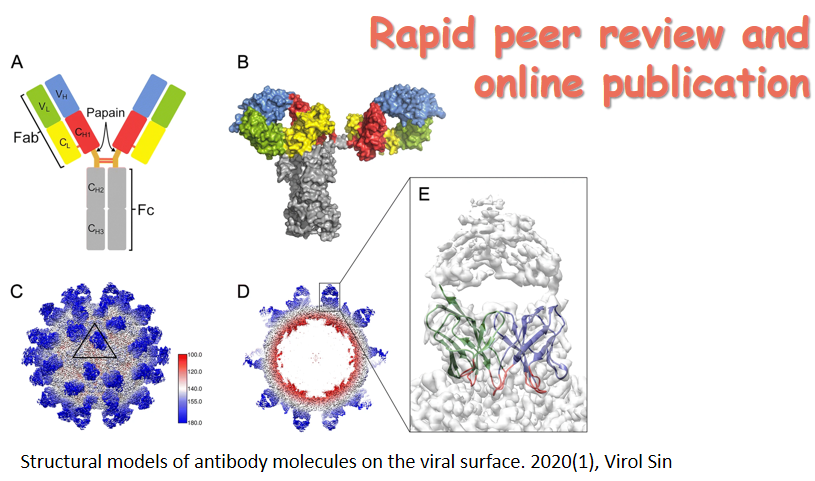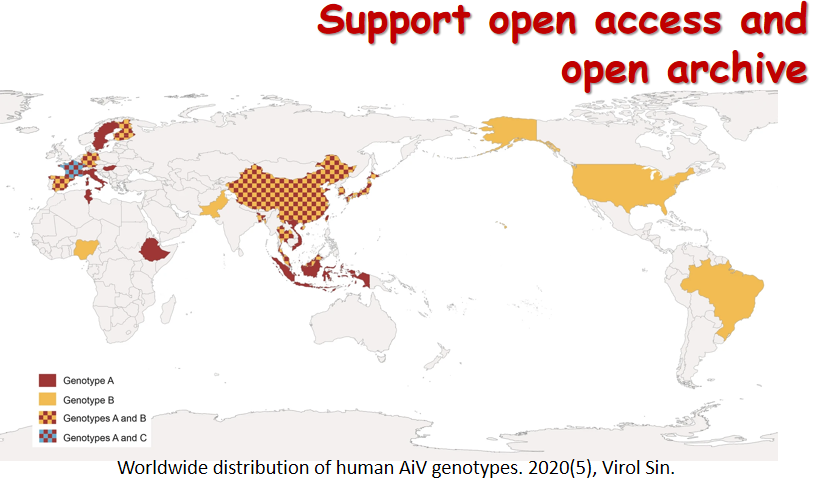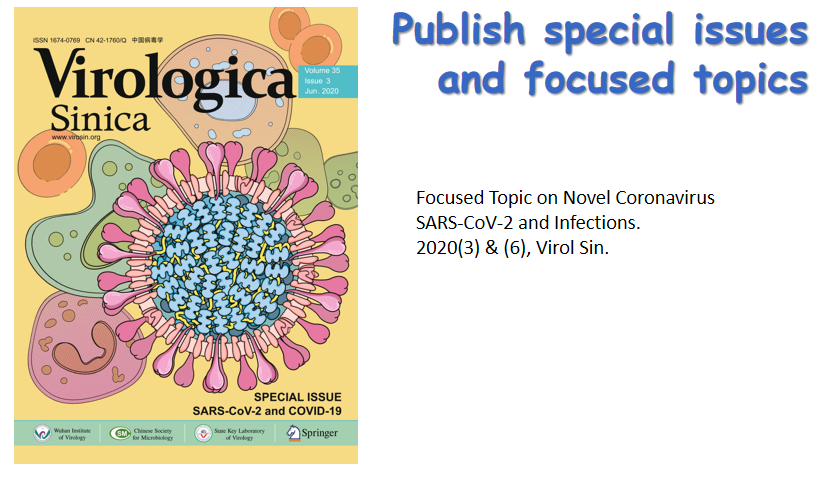Column
|
丙型肝炎病毒(hepatitisCvirus,HCV)是单股正链RNA病毒,有单一阅读框架,编码约3010个氨基酸的病毒前体蛋白。HCV基因组结构和病毒蛋白的亲疏水性与黄病毒相似,因此将其归于黄病毒科丙型肝炎病毒群。
Common primers were designed, based on M segmental sequences of two HFRSV serotypes—HTNV and SEOV, and RT PCR (reverse transcription-polymerase chain reaction) method was applied in detecting 39 strains of isolated hosts from different areas. Thirty six of the 39 samples were tested by cELISA (capture ELISA) in duplicated wells, while P/N≥2.10 and P-N≥0.10 the result was considered to the positive. The detection rates of RT PCR and cELISA were 97.6% and 82.4% respectively, 84.6% in correspondence. Fifteen of 38 RT PCR products could be digested by restriction endonuclease AluI. According to the restriction map the HFRSV detected was classified into two types——HTNV and SEOV.
A lymphoblastoid cell line (KMT 3) was established by EBV induced B cell transformation in the cotton top tamarin. The viruses were prepared from the culture fluid of B 95 8 cells by passing through a 0.45μm filter. KMT 3 can produce high titer infections EB viruses. Its VCA positive cell rate was 3~5% in natural and 50~60% after activation. Human B lymphocytes could be immortalized directly from KMT 3 supernatant. The number of chromosomes was 46.
Twenty three serum samples from blood donor, hemodialysis and hepatitis patients were collected. Using reverse transcription nested polymerase chain reaction method (RT nested PCR),the cDNA fragments of the putative envelope protein 2 (E 2/NS 1) of HCV RNA were amplified and then sequenced. Nucleotied and amino acid sequence analysis showed marked heterogeneity among isolates from 23 patients at the N terminus of E 2/NS 1.The extended sequence analysis comfirmed that the hypervariable region one (HVR 1) is located at the positions 1459~1559 in nucleotide sequence,and 384~410 in amino acid sequence. It was found that 15 amino acids of 27 amino acids of HVR 1 in Chinese HCV isolates were stable, and the composition and distribution of amino acid of HVR 1 were much different from 166 isolates reported by Sekiya. It is suggested that studying the characterization of HVR 1 HCV Chinese isolates would be helpful for investigating geographical distribution of HCV, and researching diagnosis method and vacc.
In order to study the distribution and position of HFRSV in chigger mite, in situ hybridization was used for detection of hemorrhagic fever with renal syndrome virus (HFRSV) RNA.The results showed that positive rate of HFRSV by in situ hybridization was higher than that by IFAT. Positive signals were observed mostly in belly cells of larva and nymph. The positions were probably ovary cells and midgut. A few positive signals were seen in foreleg and middle leg cells also. The positive signals of HFRSV in nymph were much more than in larva. It demonstrated that HFRSV can be transmitted by transstadial and proliferate in mites.
Enduracidin was studied for its ability to inhibit Hepatitis B Virus DNA, HBsAg and HBeAg secreted by a HBV transfected cell line (HepG 2.2.2.15). The result showed that IC 50 (the drug concentration that inhibits HBsAg or HBeAg secretion by 50%)was 27μg/mL and 34μg/mL respectively, theraputic index (TI) was 5.9 and 4.6. Enduracidin at the concentration of 50μg/mL inhibited 56.8% of the production of free HBV DNA in the Cells.
Isolates from two patients of hepatitis C in the same region were classified as genotype Ⅱ by PCR method. NS5 gene fragments of HCV were cloned, and inserted into pUC19 and M13mp18, respectively.Sequence analysis showed that the homologies of the two isolates (NS5X and NS5V) in nucleotide and amino acid are 89.4% and 90.75%,respectively. Stop codon TGA was found in NS5V at 70~72 nt. The homologies of nucleotide and amino acid between the two isolates and typical genotype Ⅱ(HCV BK)are 91.5%and 91.92%,91.91% and 91.91%. The results indicated that there is relatively high variation in HCV NS5 region between isolates of same genotype from same area, and suggested that the isolate of NS5V may be a defective virus.
With the flock house virus (FHV) capsid protein as a vector (FHV RNA 2),the epitopes corresponding to the cleavage regions of rotavirus SA11 Vp4 primed broadly cross reactive neutralizing antibodies in guinea pigs. The epitopes of SA11 Vp4:REA(223~242aa),REB(243~262aa),REC(234~251aa),and their combination REA+REB+REC were expressed on the chimeric protein surface in the recombinant pET FHV RE system,and used to immunize guinea pigs to prepare antisera. The antisera were proven to have strong cross recognizing and cross neutralizing activities to homologous SA11 virus and heterologous Wa,S2,DS 1,Ito Sty 3, St. Thomase, Gottfried, UK, and B223 virus strains. The results suggested that the amino acid sequences of rotavirus Vp4 cleavage region have important immunological functions,and when displayed in the proper positions on the FHV RNA 2 protein vector, these epitopes could be prospective as a new type of epitope based subunit vaccines.
Solid phase enzyme immunoassay (EIA) kit was developed for detecting anti HEV IgG by using synthetic peptide from the open reading frame (ORF)3 and recombinant antigens from ORE2.When the kit was applied to detect HEV antibodies in sera of clinical patients the results were quite consistent with the HEV diagnostic kit from Genlabs.The consistent rate reached 100%
(60/60).CV of three lot kit was less than 10%.The kit was stable for 8 months at 4℃or for 4 days at 37℃.The kit was used to detect anti HEV IgG among clinically different patients with acute Non A,Non B,Non C hepatitis,Hepatitis A,Hepatitis B,Hepatitis C and normal human group,the positive rates were 63.2%,13.4%,8.3%,6.6%,2.9%, respectively. The date indicated that the HEV EIA kit is sensitive,specificic and stable,may be used to detect antibody of Hepatitis E Virus among patients and normal human group.
A HBeAg gene fragment, which has some restriction endonucleased sites on both 5′ ends, including pre c signal peptide
sequence and 5′ 447 bp of the HBcAg gene was amplified by PCR. The HBeAg gene fragment was cloned into the BmNPV transfer vector pBm030 and the chimeric vector pBmHBe was constructed. The BmN cells were co transfected with pBmHBe and Wt BmNPV DNA,therefore, the recombinant viruses were obtained by plaque purification. Analysis of the HBeAg antigenecity by ELISA showed that the highest titer in the cell cultural medium was up to a dilution of 1∶32000. Although HBeAg protein also presents in the BmN cells the titer was only 1:2000. The HBcAg protein was fewer than HBeAg (<1∶160) whatever in culture medium and in cells. the results showed that the BmN cells can recognize the HBeAg signal peptide sequence and cut it correctly for HBeAg. The BmN PV BmN cell system is considered to be much better than E.coli system for producing HBeAg protein.
The location of DNA polymerase gene in the HaSNPV was determined within a 6.6kb HindⅢ J fragment,using a probe prepared from the previously identified DNA polymerase from the Helicoverpa zea single nuclear polyhedrosis virus(HzSNPV).The entire coding region of HaSNPV DNA pol was in a HindⅢ SalI fragment of 3.4kb in size.The restriction enzyme map of HaSNPV DNA pol was similar to that of HzSNPV. A 806bp fragment in the subclone was sequenced and the partial ORF containing 206aa was predicated. Compared with other six members of Baculoviridae ,the DNA polymerase of HaSNPV was highly homologous with that of HzSNPV,and it also showed certain similarity to those of LdMNPV,AcMNPV,BmNPV,CfMNPV and OpMNPV.This study can supply necessity for further attachment of the replication mechanism of HaSNPV.
Seven distinct genotypes were isolated from wild type Helicoverpa armigera single nucleocapsid NPV (HaSNPV W)by low mortality dose infection of 3rd instar H.armigera and progency viral DNAs extracted from individual cadaver were analysed by endonucleases.Each of the 7 genotypes had different EcoRI profiles.The BamHI profiles of the 7 genotypes could be distinguished by a particular fragment:the sizes of BamHI H fragment for G 1,G 2,G 3,G 4DNAs were 3.3kb,for G 5 and G 6,they were 3.5kb,and for G 7,it was 2.7kb.These results showed that the wild type HaSNPV was a mixture of at least 7 genotypic variants.
There are two filamentous wheat mosaic viruses transimitted by the plasmodiophoraceous fungus Polymyxa graminis :one is wheat spindle streak mosaic virus (WSSMV)first reported in Canada and the other is wheat yellow mosaic virus (WYMV) first reported in Japan .These viruses are very similar in particle morphology,biological and serological properties, but different in genomic sequences. The results of RT-PCR and single strand conformation polymorphism analysis (SSCP) indicated that the fungal transmitted filamentous wheat mosaic viral pathogen occurred in successive crops at different sites in China is wheat yellow mosaic virus. SSCP analysis with the fragments amplified using several primer sets all gave different patterns ,indicating the presence of sequence variations among eight isolates collected at different sites in China.
Seventy two clinical specimens of saliva,throat swabs and urine collected from clinical mumps cases were examined by the
nested RT PCR, 69 (86.1%) of them were positive. The results showed that the positive rate of the urine specimens (25%) was significant different (P<0.005) from that of the saliva (100%) and the throat swab (96.6%) specimens.The Enders strain of mumps virus was used as the positive control and measles virus,new castle disease virus,influenza viruses (A1,A3,B) and rotavirus were used as the negative controls for confirming the specificity of the method.The sensitivity test of the method indicates that at least 1TCID 50 mumps virus or 1~10pg DNA of cloned SH gene plasmid can be detected.This method can be used for clinical detection of the mumps virus with high sensitivity and specificity.

















